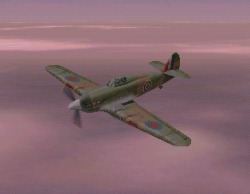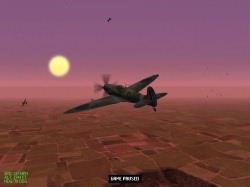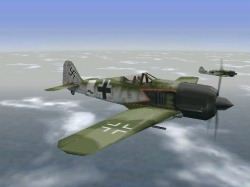| Cold Steel: EAW Aircraft by Jim "Twitch" Tittle |
||||
|
HAWKER HURRICANE I & II While the Spitfire was better known, it was the "Hurri" that was more proliferous during the Battle of Britain. The first Hurricanes appeared with the RAF in 1937-38. A 1,030 h.p. Merlin III V-12 powered the Mk.I to a top speed of 324 m.p.h. @ 16,250 ft. The Hurricane possessed an edge in maneuverability over the Bf 109E up to 20,000 feet and was a stable gun platform for its eight .303 machine guns each carrying 334 rounds. Climb rate was a meager 2,400 f.p.m. Ceiling was 34,200 ft. Its range of 425 mile could be increased with drop tanks to 900 miles. The Hurricane was exported to numerous countries and fought with the RAF in every theater of operation. During the Battle of Britain it was relegated to bomber attack while the Spits mixed it up with the Luftwaffe fighters. The Mk. II's 1,460 Merlin XX boosted performance to 342 m.p.h. @ 22,000 ft. and climb to 2,750 f.p.m. Maximum range increased to 460/985 internal/external fuel and ceiling was upped to 36,500 ft. Weaponry now boasted twelve .303s or four 20mm cannon in the IIC and 1,000 lbs of bombs. SUPERMARINE SPITFIRE Ia Using the same 1,030 h.p. Merlin III V-12 as the Hurricane I, the sleeker Spit could manage 365 m.p.h. @ 19,000 ft. with a climb rate of some 2,500 f.p.m. Though the Mk Ia was appreciably more maneuverable than the Bf 109E, the German machine could out climb and out dive it. The eight Browning .303s with 300 r.p.g. were undermatched to the 109E also. Ceiling was 34,000 feet and range was 575 miles. The 19 RAF squadrons held the line and beat back the Luftwaffe during the Battle of Britain. SUPERMARINE SPITFIRE MK. IX While better than the Mk. V, the IX still was surpassed in most cases by the FW 190. The 1,710-1,720 h.p. Rolls Royce Merlins varied the IXE's maximum speed from 404 m.p.h. at 21,000 feet to 416 m.p.h. at 27,000 feet. The ceiling ranged from 42,500 to a whopping 45,000 feet! The IX was the first to mount two .50's with 250 r.p.g. along with two 20mm Hispano cannon carrying 120 r.p.g. On internal fuel range was just 434 miles and with maximum external still only 980. Climb rate was a healthy 3,500 f.p.m. When needed, the Spit could carry 1,000 lbs of bombs. SUPERMARINE SPITFIRE MK. XIV Enter the Rolls Royce Griffon IV with 2,050 h.p. turning a five blade prop. A whopping 448 m.p.h. could now be achieved at 26,000 feet and climb rate was 4,500 f.p.m. Ceiling was touched at 44,500 ft. Maximum external fuel yielded only 850 miles range. But the optimum armament of four 120 r.p.g. 20mm Hispano cannon was excellent when compared to Messerschmitts overall. Many XIVs carried two 20s and four .303s. Rear vision was finally improved with the bubble canopy and cut down rear fuselage deck. 500 lbs of bombs could be hauled in dive bombing duties. The Mk. XIV was able to dive at 550 m.p.h. and the first Me 262 to fall victim to an Allied pilot was done in by a XIV. HAWKER TYPHOON Ib Conceived as an interceptor, the Typhoon was rushed into RAF service. A 2,180 h.p. 24 cylinder Napier Sabre IV engine powered this very large to a top speed of 405 m.p.h. @ 18,000 ft. But altitude performance was not there and structural problems plagued the plane. Climb was a meager 2,420 f.p.m. |
The main fault lay in the severe buffeting and failure of the tailplane in dives. Many a plane took its pilot to his death in this manner. But at low altitude the Typhoon faired better. With four 20 mm cannon with 150 r.p.g. it enjoyed success against Fw 190s and Me 210s raiding the Empire. Its premiere role became ground pounding. With the ability to carry 2,000 lbs of bombs or eight rockets, the plane excelled at tank busting. With a bomb load range was 510 miles. Clean it increased to 610 and with external fuel 1,000 was maximum. HAWKER TEMPEST V A wing designed out of the Typhoon failure rectified the Typhoon II problems. The design differed so much the new aircraft was named Tempest. By the time the V arrived in squadrons in 1944 using converted Typhoon airframes, the Tempest was a worthy weapons delivery system. Its 2,200 h.p. Napier Sabre IIB 24 cylinder was like two flat 12 cylinder engines, one atop the other forming an "H." Performance was superior to the Typhoon with a 435 m.p.h. maximum speed seen at 17,000 feet. Ceiling was 2,000 feet higher than the Typhoon at 36,000 feet and range increased to 820/1,300 miles on internal/external fuel. The same Typhoon bomb load or rocket payload applied to the Tempest. But the main treasure was the ability to climb at 4,700 f.p.m. Coupled with four short barreled Hispano Mk. V 20mm's with 150 r.p.g. the Tempest V was all the Typhoon was originally hoped for. French pilot Pierre Closterman flew the Tempest and scored 33 victories by war's end. DE HAVILLAND MOSQUITO Made out of wood to conserve valuable metal, the two seat Mosquito was the versatile British version of the Zerostrorer. As a light bomber carrying 4,000 lbs. of ordnance it was fast at 408 m.p.h. As a recon aircraft it had altitude performance and a range of 1,870 miles. In fighter trim it mounted four .303 caliber guns with 500 rounds each along with four 20mm cannon with 150 r.p.g. Merlin V-12s from 1,290 to 1,710 h.p. powered the "Mossy." There was a night fighter version that accompanied heavy bombers to Germany. Anti-shipping duties saw rockets slung under the wings and the installation, in one model, of a 57mm cannon. FOCKE WULF FW 190 D-9 Removing the 18 cylinder BMW radial and replacing it with a 1,770 h.p. Junkers Jumo 213 A-1 inverted V-12 made for a spectacular increase in performance of the A-8 airframe. The D-9 was created purely as an interceptor. The outboard two of the four 20mm MG 151 cannon in the wings were replaced with the MW 50 (methanol- water) power boost which raised power to 2,240 h.p. Climbing at 3,400 f.p.m., the "Dora's" two 20mm's with 250 r.p.g. and two 13mm machine guns with 475 r.p.g., were ample armament. The D-9 was basically the same weight as the A-8 with the radial. Two feet is all the Jumo added to the nose and an extra 1 1/2 in the tail for center balance compensation. Maximum speed at sea level was 357 m.p.h. and rose to 426 m.p.h. at 21,653 feet. Range was 520 miles, and adequate for its mission. Go to Page Three
|
|||
|
This material is copyrighted and may not be reprinted in any form without
permission of the publisher.
Last Updated November 1st, 1998 |
||||



